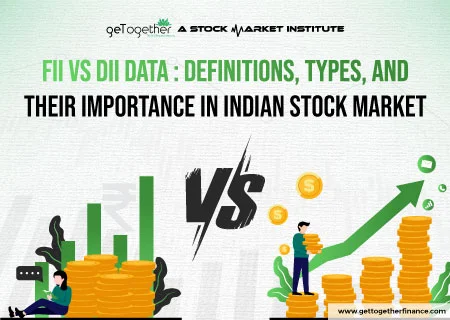FII DII Data : Definitions, Types, and Their Importance in Indian Stock Market


Table of Contents
ToggleOverview
Indian stock markets saw a shift in 2023, with domestic investors (DIIs) investing a significant ₹1.83 lakh crore ($22 billion) compared to foreign investors (FIIs) at Rs 1.46 lakh crore ($17.5 billion).
When it comes to the Indian stock market, both institutional and retail investors are open to participating in investing and trading. Institutional investors are companies or large firms that invest big chunks of money, pooled from individuals or other sources. But this also gives them the power to change the course of price direction, since they deal with large blocks of securities.
In the financial world, they are mainly classified into two types; DII and FIIs. This blog will discuss their in-depth definitions and types. Further, it will explore how FII DII data impact that market using suitable examples.
So let’s begin.
What is FII?

FII stands for Foreign Institutional Investor. These are institutions based typically outside of a specific country that invest in the stock market. They play a significant role in the Indian financial market by providing a source of foreign capital.
Let’s assume Foreign Institutional Investor is a group of investors from foreign who come to India to invest in its companies. Their decisions to buy or sell Indian stocks can impact the overall market sentiment and stock prices.
You could touch upon how Foreign Institutional Investor investments can increase market liquidity, offer access to new investment opportunities, and potentially improve corporate governance standards through increased scrutiny.
Since such companies are external, they must register and operate under the SEBI regulations. These entities are also known as FPI (Foreign Portfolio Investors). Due to the significant change in the currency value, depending on the company’s origin state, their benefit and losses can vary and be significant.
Types of FII

FII (foreign institutional investors) are mainly classified into four key bodies. Here is a breakdown:
Sovereign Wealth Funds (SWFs)
These are investment funds owned by national governments. They typically invest excess revenue from a country’s resources (oil, gas) for long-term benefits. SWFs are known for being stable investors due to their long-term investment.
Foreign Government Agencies
Government agencies from other countries may invest in the Indian market to diversify their portfolios or for strategic reasons. Their investment decisions might be influenced by political or economic considerations alongside financial returns.
International Multilateral Organisations
These are organizations with member countries, like the World Bank or Asian Development Bank. They may invest in the Indian market to support economic development or promote specific initiatives.
Foreign Central Banks
Central banks of other countries may invest in the Indian market as part of their foreign exchange reserves management strategy. Their investment decisions can be influenced by currency exchange rate management and global economic conditions.
Also Read: Anchor Investors
What is DII?

DII or domestic institutional investors, are institutions based in India that invest in the Indian stock market. They play a crucial role in the Indian financial system by mobilising domestic savings and channeling them into productive investments.
DII investments contribute to the long-term growth of the Indian stock market and provide stability compared to Foreign Institutional Investor who might be more susceptible to short-term global market fluctuations. Their buying and selling activity can significantly influence stock prices and market stability.
They can also invest their capital in major investments such as mutual funds, insurance companies, pension funds, etc. Mostly their decisions are influenced by the economy and politics. Akin to Foreign Institutional Investor, DII can also majorly influence the decision or course of the stock market, especially when DII is buying when FII decides to sell more.
Types of DII

Like Foreign Institutional Investor, there are major four types of DII that include most categories of Domestic Institutional Investors:
Indian Insurance Companies
These firms collect premiums from policyholders in India and invest a portion of those funds in Indian stocks and bonds. This offers long-term returns for policyholders while also contributing to the growth of the Indian market.
Indian Mutual Funds Corporations
Mutual funds pool money from individual Indian investors and invest it in a diversified portfolio of assets, including Indian stocks. This allows individual investors to participate in the stock market even with smaller investment amounts.
Indian Banks & Other Financial Institutions
Banks collect deposits from individuals and businesses in India. They may invest a portion of these deposits in Indian stocks and bonds to generate additional income. Other financial institutions like Pension Funds and Provident Funds also fall under this category. They manage retirement savings or social security contributions and invest a portion in the Indian market for long-term returns.
Other Categories of DII

Here are few other categories or types of DII (Domestic Institutional Investors):
Public Provident Fund (PPF)
While not strictly a DII itself, PPF deposits from individuals contribute to government investments, which can indirectly impact the market.
Non-Banking Financial Companies (NBFCs)
These institutions may also invest in the Indian stock market, but their role is generally smaller compared to the three main DII categories.
Impact of FII DII

Foreign Institutional Investors and Domestic Institutional Investors are major players in the Indian stock market, collectively influencing around 35% of transactions. Their investment decisions can significantly impact market movements and investor sentiment. Here’s a closer look at their roles and recent trends.
Boosting Confidence and Reserves
Investment Activity
Both investments can boost confidence among smaller investors who might follow their lead. This positive sentiment can contribute to market growth.
Foreign Exchange Reserves
FII investments bring foreign capital into India, strengthening the country’s foreign exchange reserves. This benefits the government and RBI in managing financial activities.
Let’s take the example of the 2021 boom. During the COVID-19 boom in 2021, domestic investors (DIIs, retail) provided crucial support despite FII’s reluctance to invest.
Impact on Volatility
The Indian stock market is known for its volatility, and FII and DII activity plays a role:
- FII Buying: Large-scale buying by FIIs often leads to market upswings.
- FII Selling: Conversely, significant FII selling can trigger withdrawals and market declines.
- DII Activity: DIIs tend to act as a counterbalance to FII activity, providing some stability.
Understanding the interplay between FII DII data is crucial for anyone interested in the Indian stock market.
How Do FIIs and DIIs Work?

Foreign Institutional Investors (FIIs) and Domestic Institutional Investors (DIIs) play crucial roles in financial markets. Here’s how they operate:
- Registration: FIIs and DIIs must register with the regulatory authorities of the country. In India, this is the Securities and Exchange Board of India (SEBI).
- Fundraising: They raise capital from various sources, including pension funds, hedge funds, and other institutional investors.
- Investment Strategies:
- FIIs often employ short-term strategies, engaging in active trading to exploit market movements.
- DIIs typically adopt long-term approaches, focusing on strategic investments.
- Create Demand and Supply: With their huge volume of orders, both DII and FII collectively holds the potential of create massive number of supply or demand of specific stocks or indices. This can create a significant impact on stock price, generating selling or buying pressure and eventually pushing the price upward or downward.
FII flows are closely watched by the market as they can significantly impact stock prices and market sentiment. DIIs, such as mutual funds and insurance companies, also influence demand and supply through their trading.
Key Differences from Retail Investors
- Extensive Research: Institutional investors conduct thorough market analysis and research before making investment decisions.
- Bulk Purchases: They have the capacity to make large-scale investments, influencing market trends significantly.
Understanding these distinctions can help you grasp how FIIs and DIIs impact the financial markets differently compared to retail investors.
Conclusion
FIIs and DIIs are big players in the Indian stock market. FIIs used to have more influence, but now DIIs are catching up, making things more balanced. DIIs bring stability with their long-term investments, while FIIs add some excitement with their short-term moves. Knowing their strategies helps investors make better decisions. As more Indians start investing, the market could become more stable and less affected by foreign money.
FAQs
What is FII DII Data?
FII DII data refers to information about the investment activity of Foreign Institutional Investors (FIIs) and Domestic Institutional Investors (DIIs) in the Indian stock market. This data typically tracks the net amount of money FIIs and DIIs are buying or selling on the Bombay Stock Exchange (BSE) and National Stock Exchange (NSE) of India.
Where can I find FII DII Data today?
Many financial websites and apps provide FII DII data. You can find it on the websites of the BSE, NSE, or financial news platforms.
How often is FII DII activity data updated?
FII DII data is usually updated daily, showcasing the net buying or selling activity of these institutions on a particular day.
What can FII DII data tell me?
FII DII data can provide insights into investor sentiment and potential market movements. High FII buying might show bullish sentiment, while major FII selling could tell a bearish outlook. Similarly, DII activity can also influence market direction.
Is FII DII data the only factor to consider when making investment decisions?
No, FII DII data is just one piece of the whole picture. While it can be valuable, you should combine it with other factors like company financials, economic data, and your own investment goals before making any investment decisions.
Can I use FII DII data for technical analysis?
Yes, some technical analysts use FII DII data alongside other indicators like price charts and volume to identify potential trading opportunities. However, technical analysis is a complex subject, and it’s recommended to gain a good understanding before using it for trading.
Why is it important to understand the difference between FII and DII?
FIIs and DIIs have different investment horizons. FIIs tend to focus on short-term gains, while DIIs often invest for the long term. This difference can impact their trading activity and influence the market.
How has the role of FII and DII changed in the Indian stock market?
Traditionally, FIIs held more sway over the market. However, with the rise of domestic investors, DIIs are playing a more prominent role. This shift suggests a maturing market with growing domestic participation.
What are some limitations of using FII DII data?
FII DII data only reflects net buying or selling activity, not the specific stocks or sectors these institutions are investing in. Additionally, the data doesn’t provide any insights into their investment rationale.
What do FIIs and DIIs use the money they invest for?
FIIs and DIIs use investment money differently. FIIs focus on short-term returns, buying stocks for quick gains or trading based on market movements. DIIs take a long-term view, investing in companies with growth potential for the benefit of their domestic investors.



 Facebook
Facebook Instagram
Instagram Youtube
Youtube
